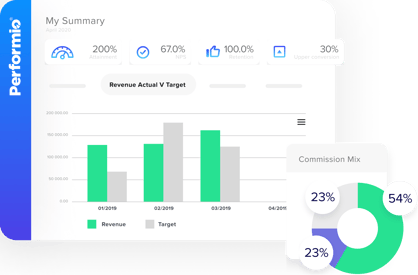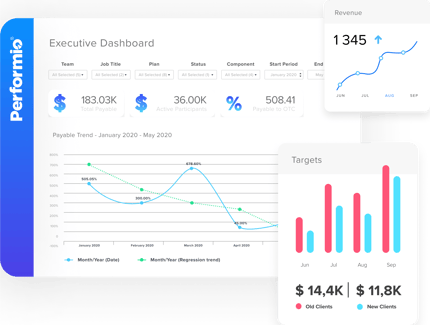In a recent Performio “Weekly Challenge” (a fun activity we do each week in Slack to foster engagement and culture that keeps team members connected), the challenge was, “Get on Your Soapbox: What incredibly strong opinion do you have that is completely unimportant in the grand scheme of things?”
There were fierce debates on everything ranging from food to television characters. Then this one caught my eye from Brie in Partner Services, “Kirk vs Picard: Picard was, by far, the superior Starfleet captain. Don't get me wrong, I think Kirk was a very good captain, but Picard was better.” But before I could drop the Austin Powers gif, “Nerd Alert!” I thought about this post.

Maybe it’s because Picard had Data…
.gif?width=199&height=166&name=giphy%20(1).gif)
You know, the lifelike AI powered Humanoid portrayed by actor Brent Spiner.
And during a time in our history where AI is all the rage, what is AI really powered with?...Data. But, any way you slice it, if your data isn’t clean, you’re going to have some messy AI. The same is true when measuring just about anything and when it comes to performance what good is data if it can’t be understood, aggregated, visualized.
In sales, rewards should always be tied to performance. Your sales reps should each receive payouts that are consistent with the value they bring to the organization. Their compensation should be fair, and it should motivate them to increase their performance even further.
But this requires measurement through a codified process that you can apply equally to everyone.
With so many potential metrics to track, it can feel like an overwhelming process to figure out which ones best apply. In this article, we’ll walk you through some of the most important considerations to keep in mind. And whatever standards you decide on for evaluating performance, Performio’s Incentive Compensation Management (ICM) software can help you track and report on it.
What are the types of metrics for evaluating sales performance?
The metrics you use to evaluate sales performance can be broadly divided into overlapping groups of quantitative metrics versus qualitative metrics, and individual metrics versus group metrics. They can be thought of as a matrix:
| Quantitative metrics | Qualitative metrics | |
| Individual metrics | Track the performance of each sales rep based on objective numbers | Track the performance of each sales rep based on subjective feedback |
| Group metrics | Track the performance of the sales team based on objective numbers | Track the performance of the sales team based on subjective feedback |
Let’s take a closer look at each category.
Quantitative metrics
Quantitative metrics are the objective, numbers-driven stats that can be used to describe how well your sales reps and team are performing.
Because they’re based on hard data, quantitative metrics give you a picture of performance that doesn’t rely on feelings, guesswork, or wishful thinking. You can turn these metrics into reports with visualized charts and graphs to show others, and you can back up your claims with proof.

Additionally, using quantitative metrics to evaluate performance can reduce the impact of potential biases or personality conflicts that may give unfair advantages to some people over others. They help to ensure that employee advancement is based on individual merit, rather than any kind of favoritism. And if a question of favoritism ever does come up, quantitative metrics provide a paper trail to help demonstrate whether the claim has any merit.
But that doesn’t mean quantitative metrics give a perfect view of relative performance. You have to make sure that your quantitative metrics are fair evaluation standards, and not reflective of factors outside your team member’s control or biases. For instance, if one of your sales people is tasked with managing small accounts, but you evaluate based on average deal size, that metric won’t reveal performance—it’ll just reflect their given responsibilities.
There are a wide variety of quantitative metrics you can use for evaluating sales performance, and which ones you track will depend on the specifics of your business, customers, and sales processes. A few examples include:
- Quota attainment
- Win rate
- Conversion rate
- Sales cycle length
- Open opportunities
- Closed opportunities
- Qualified leads
- Lead response time
- Lead follow-up percentage
- Dropped leads
- Number of phone calls, emails, or other forms of communication
- Average deal size
Good ICM software like Performio can automatically track all of these metrics and more, giving you constant insight into your sales reps’ quantitative performance, and easily generating reports as needed.
Qualitative metrics
Although qualitative metrics can’t be tracked quite as objectively, they’re still important to consider.
For example, there may be no number you can attach to how well a sales rep gets along with their co-workers. But if HR is getting frequent complaints about a certain individual, they’re clearly having a negative impact on the workplace environment, and teamwide performance will suffer as a result.
Some qualitative metrics may come with a number—but one that was arrived at through subjective means. You might send out follow-up surveys to your customers to have them evaluate their experience with a sales rep on a scale of one to five. The number they pick may not be scientific, but it isn’t irrelevant either.
How much weight you give to qualitative metrics will depend on the specific context, and you may need to exercise judgment about how to proceed with them. If a sales rep routinely gets ratings of four and five, then a single rating of one may just be a customer having a bad day. But if the rep consistently gets more ones and twos than the average rep, something needs to be addressed.
Other possible qualitative metrics include:
- Helpfulness: Do they support other team members when they need assistance? Share successful tactics? Are they mentoring anyone?
- Growth: Do they learn from their mistakes? Study customers’ industries? Stay up to date? Are they able to recommend books, articles, or other resources?
- Salesmanship: Do they negotiate well? Perform well on the spot? How do they handle objections or difficult customers? Are they able to respond with grace and diplomacy?
- Conscientiousness: Do they report on time? Arrive prepared for meetings or calls? Leave an area looking as good or better than it did when they arrived?
- Team spirit: Do they take initiative to celebrate wins? Foster a positive attitude? Encourage other team members? Keep a level head during crises?
- Remarkableness: Do customers mention them by name? Do their colleagues often bring them up? What do others have to say about them?
- Personality type: Tools like Clifton StrengthsFinder 2.0 and ProScan can highlight employees’ individual qualitative strengths, which can be used to evaluate the qualitative strengths of the overall team.
And qualitative metrics aren’t just for individual reps. You can also use them to evaluate the overall performance of the sales team, observing things like customer feedback, brand credibility, and brand trust.
Use these qualitative metrics to gain a fuller understanding of how well your sales team is doing.
Individual metrics
Individual metrics show how each specific rep is performing in relation to their quotas and goals, as well as in comparison to your other sale’s reps. These metrics include many of the metrics we’ve already discussed, such as win rate and sales cycle length (quantitative) and growth and remarkableness (qualitative).
Attention to individual metrics is important in order to keep each sales rep on track with where they ought to be, as well as to reward higher-performing reps with well-deserved recognition and greater compensation.
With an ICM like Performio, you can easily see how all your sales reps are performing. And reps themselves gain real-time transparency into their progress, letting them know how far along they are toward their goals, whether they need to make adjustments to get back on track, and how much they can expect to earn. Performio even provides leaderboards you can use to promote friendly competition.
Group metrics
While you certainly want each rep to be doing their best on an individual level, their ability to work effectively as a team is what can really push your company forward. Sales reps should collaborate, share tips and strategies, and ensure that everyone succeeds together.
If the team is performing well as a group, you can afford more fluctuation in individual performance. Because let’s face it—people aren’t machines. Every rep will have some months where they don’t perform as well as usual. But with a good team, those fluctuations balance each other out and allow your business to continue growing.
When your team succeeds as a whole, they should be rewarded as a whole. That’s why your compensation plan should include team components as well as individual components. So you’ll need to track those quantitative and qualitative metrics for your overall teams as well as for individuals.
The specific metrics here are largely the same as those used on the individual level, but applied to the team as a whole. For example, on the quantitative side, rather than looking at the quota attainment of an individual, you’d be looking at the overall quota attainment for the whole group. Or on the qualitative side, you might be looking at the overall helpfulness of the team as gauged by customer feedback.

Performio has you covered here too, with software built for collaboration and inter-departmental communication. You’ll be able to easily see and report on the performance of your whole team.
What role do time horizons play?
Many of your metrics will be focused on short-term results, as that’s the easiest way to compensate sales reps for their work. You don’t want them to have to wait too long to be rewarded, or it’ll decrease motivation and affect performance.
However, you also don’t want to rely entirely on short-term results, or you could lose focus of the big picture and end up paying for it in the long run.
So it’s important to also include long-term metrics in your evaluation and compensation plans. For example, don’t just track sales made each month and quarter, but also every year, five years, and decade. Establish specific goals to reach in each case.
Make sure your focus isn’t only on immediate sales, but includes investments in things like growing the lead pipeline, rolling out new products or services, and gaining long-term customers with a high CLTV.
This will keep your team focused on making sales that best contribute to your company’s big-picture goals, and it will provide a more balanced perspective on your team’s overall performance.
Should you rely on salary benchmarks?
Salary benchmarks can serve as a starting point for determining how much to pay your salespeople. Large consulting firms like Hudson publish annual salary surveys which benchmark sales roles by:
- State
- Seniority
- Industry
These surveys provide a range of what each sales role can earn, but they don’t show the breakdown between base and performance pay. They also fail to account for variables like:
- Individual, team, or company performance
- Signing new business versus repeat business
- Variation in sales cycles between products/services
- Size of territories
And keep in mind that pay should always be commensurate with expectations. So if your business has above-average expectations for your reps, then they should receive above-average benefits as well.
So while benchmarks may help you get started by defining the broad bounds of acceptable pay, you’ll need to move beyond them to determine appropriate compensation for your sales reps in the context of your specific business.
How should you approach rewards and consequences?
It’s common for sales team performance to be measured over a distribution curve, with a curve of 20/60/20 being fairly typical. Under this structure, the top 20% of salespeople earn more rewards, and the bottom 20% are subject to review to see whether they’re a good fit for the role or company.
However, you need to be smart about how you approach this. Being in the bottom 20% doesn’t automatically mean that these sales reps have failed—especially if they’re still meeting their quotas. After all, there will always be people filling that bottom 20%, even if everyone performed well. Depending on the quality of your team, your bottom 20% could even be top performers if they were at another company! So while it can be helpful to understand your reps’ performance in relation to each other, it’s crucial that businesses don’t read into this too much, or you’ll have constant churn on your team—and you might be handing top talent over to your competitors.
In the case where reps are failing to meet their quotas, it’s worth looking into what has caused their performance to suffer. While it’s possible that they’ve just been slacking off, it could also be that they’ve been assigned particularly difficult territories or that they haven’t been afforded some of the same opportunities as your middle to top performers.
Ideally, you should try to find and address the root of whatever is causing the poor performance to help those reps up their game. Not only is it the more growth-oriented approach, but it can also save your business the expense of hiring and training new people.
Track and improve performance with Performio
Performio is all about performance—that’s where we got our name! We exist to help businesses maximize the performance of their sales teams, and we do so by providing insights and transparency into every aspect of the sales process.
Our software tracks everything for you, providing sales managers with all the data they need to keep their teams on course toward meeting their goals, and giving sales reps a real-time window into how they’re doing and what they can expect to earn.
To learn more about how to not only track but improve performance, check out our free ebook, Maximizing Sales Performance During an Economic Downturn: How to Motivate Sales Teams and Drive Revenue.
And if you’re ready to see how Performio can help your business, request a demo today.

